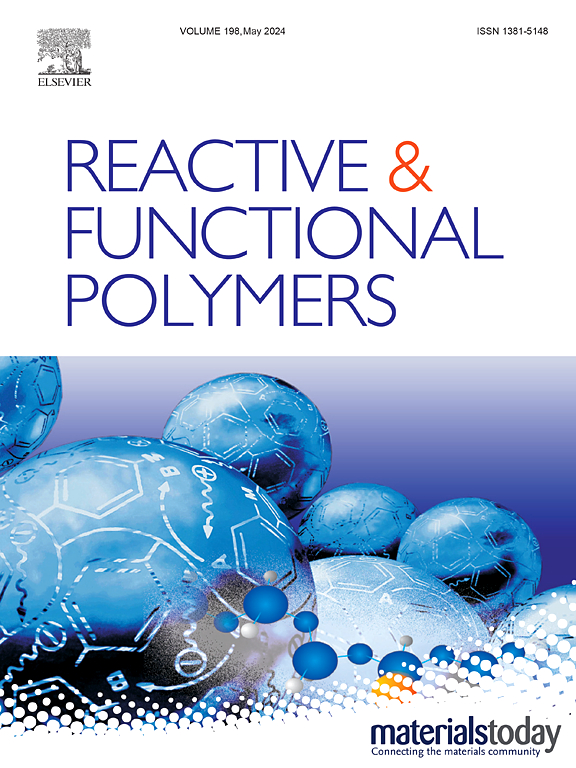针入线:用于传感涂层的紫外固化离子液体单体在石墨烯中的嵌入和分散
IF 5.1
3区 工程技术
Q1 CHEMISTRY, APPLIED
引用次数: 0
摘要
咪唑离子基离子液体(ILs)利用其与石墨烯的π-π共轭和阳离子-π相互作用,增强了石墨烯在复合材料中的分散稳定性。本研究成功合成了一种可紫外光固化的离子液体单体(UV-IL单体)1-[(6-甲基丙烯酰氧基)-己基]-3-甲基咪唑氯,并用1H NMR和FT-IR对其进行了表征。为了提高还原氧化石墨烯(rGO)的分散稳定性和导电性,将氧化石墨烯(GO)与氨基功能化离子液体接枝,通过共价和非共价相互作用得到还原修饰氧化石墨烯(RMGO)。将所得的RMGO掺入到uv固化涂层中以制造导电传感材料。系统地研究了该涂层的导电机理和传感性能。结果表明,涂层的导电性是由RMGO与离子液体的协同作用引起的。该传感涂层具有优异的温度响应性,其响应曲线遵循离子液体的Vogel-Tammann-Fulcher (VTF)方程和石墨烯的线性电阻-温度关系的组合函数。这些发现突出了这种复合材料在温度传感应用方面的巨大潜力。本文章由计算机程序翻译,如有差异,请以英文原文为准。

Needle into the line: Intercalation and dispersion of UV-curable ionic liquid monomers in graphene for sensing coating applications
Imidazolium ion-based ionic liquids (ILs) have been employed to enhance the dispersion stability of graphene in composite materials, leveraging their π-π conjugation and cation-π interactions with graphene. In this study, a UV-curable ionic liquid monomer (UV-IL monomer), 1-[(6-methacryloyloxy)-hexyl]-3-methylimidazolium chloride, was successfully synthesized and characterized using 1H NMR and FT-IR spectroscopy. To improve the dispersion stability and electrical conductivity of reduced graphene oxide (rGO), graphene oxide (GO) was chemically modified by grafting with an amino-functionalized ionic liquid, yielding reduced modified graphene oxide (RMGO) through covalent and non-covalent interactions. The resulting RMGO was incorporated into a UV-cured coating to fabricate a conductive sensing material. The conductive mechanism and sensing properties of the coating were systematically investigated. Results demonstrate that the conductivity of the coating arises from the synergistic effect between RMGO and the ionic liquid. The sensing coating exhibited excellent temperature responsiveness, with its response curve following a combined function derived from the Vogel-Tammann-Fulcher (VTF) equation for ionic liquids and the linear resistance-temperature relationship of graphene. These findings highlight the promising potential of this composite for temperature-sensing applications.
求助全文
通过发布文献求助,成功后即可免费获取论文全文。
去求助
来源期刊

Reactive & Functional Polymers
工程技术-高分子科学
CiteScore
8.90
自引率
5.90%
发文量
259
审稿时长
27 days
期刊介绍:
Reactive & Functional Polymers provides a forum to disseminate original ideas, concepts and developments in the science and technology of polymers with functional groups, which impart specific chemical reactivity or physical, chemical, structural, biological, and pharmacological functionality. The scope covers organic polymers, acting for instance as reagents, catalysts, templates, ion-exchangers, selective sorbents, chelating or antimicrobial agents, drug carriers, sensors, membranes, and hydrogels. This also includes reactive cross-linkable prepolymers and high-performance thermosetting polymers, natural or degradable polymers, conducting polymers, and porous polymers.
Original research articles must contain thorough molecular and material characterization data on synthesis of the above polymers in combination with their applications. Applications include but are not limited to catalysis, water or effluent treatment, separations and recovery, electronics and information storage, energy conversion, encapsulation, or adhesion.
 求助内容:
求助内容: 应助结果提醒方式:
应助结果提醒方式:


